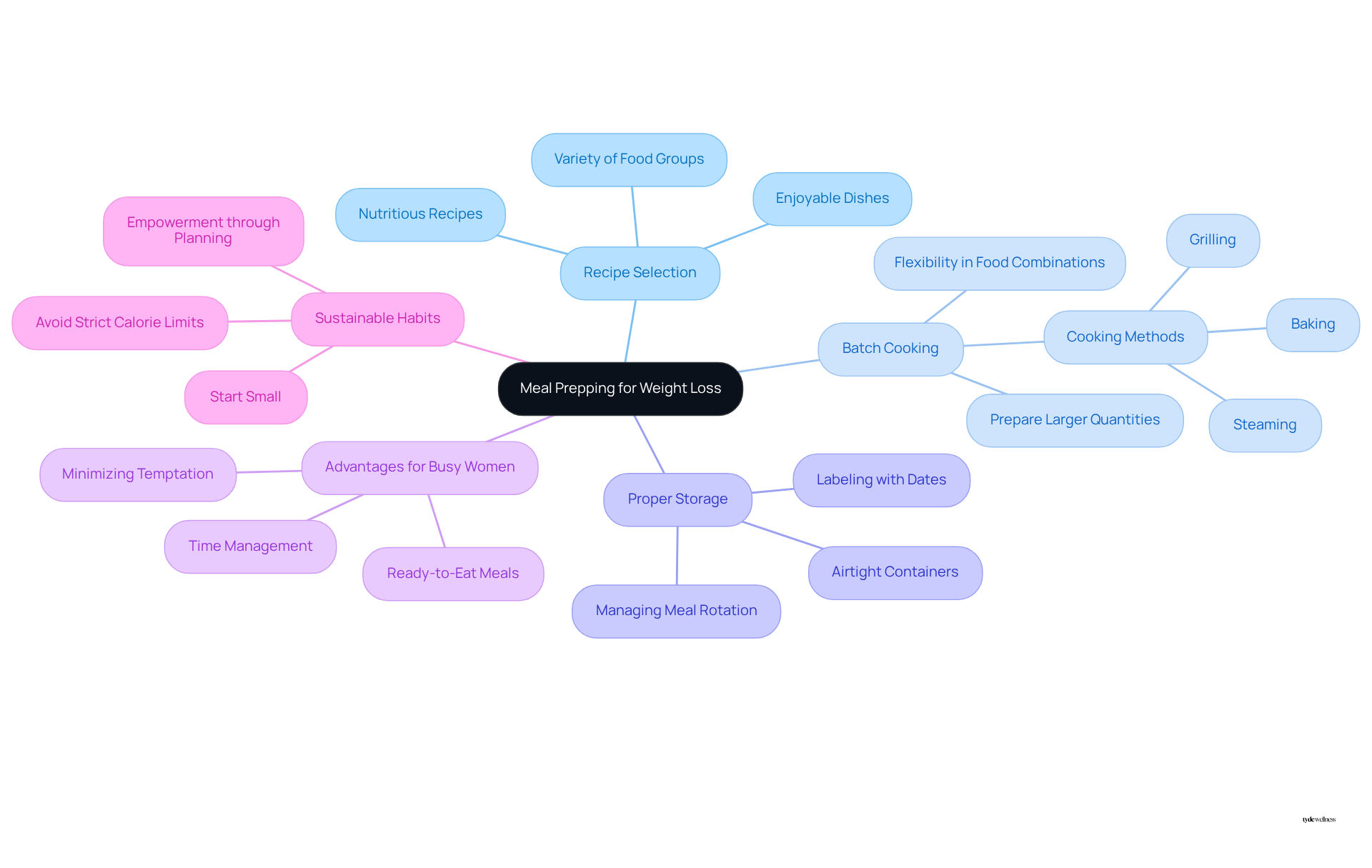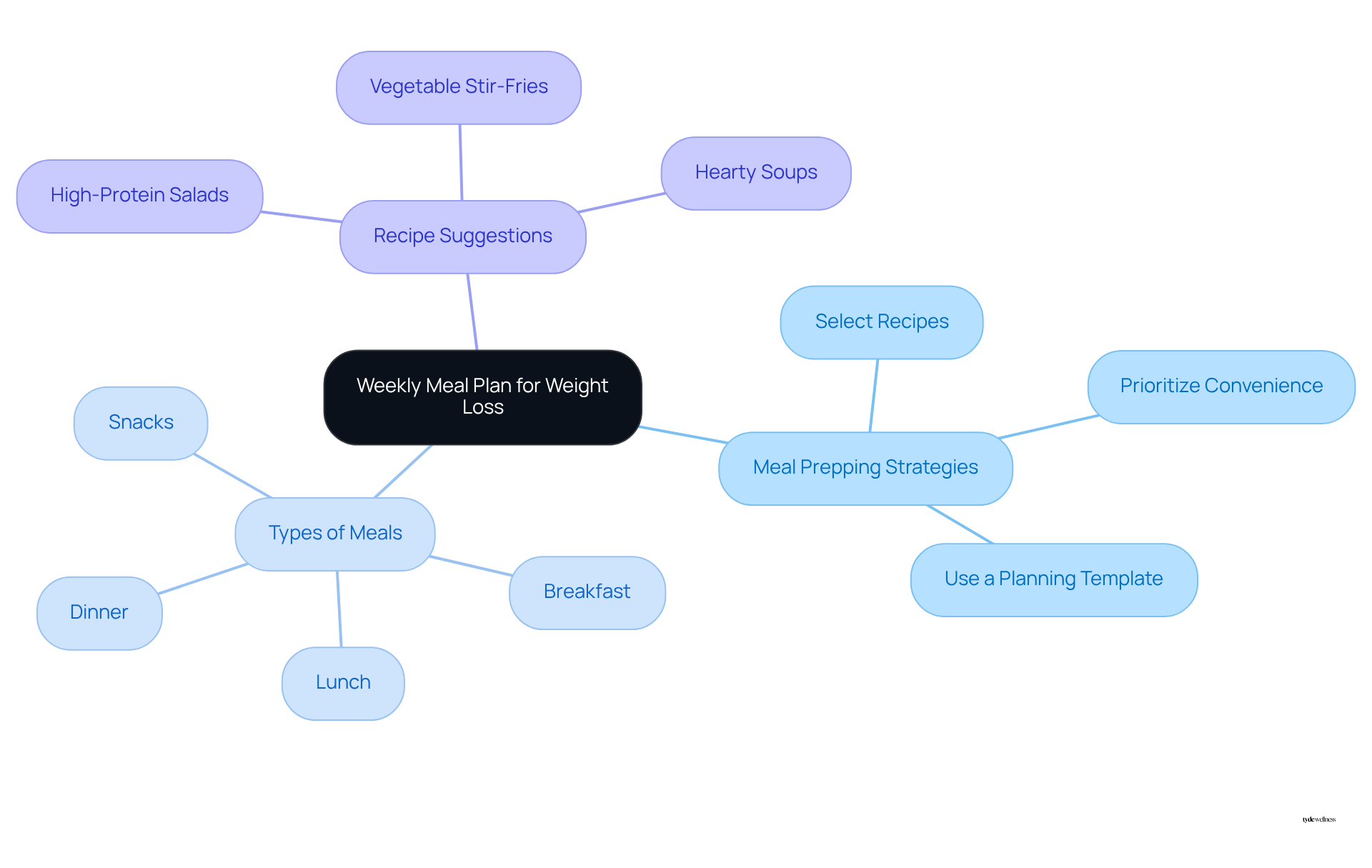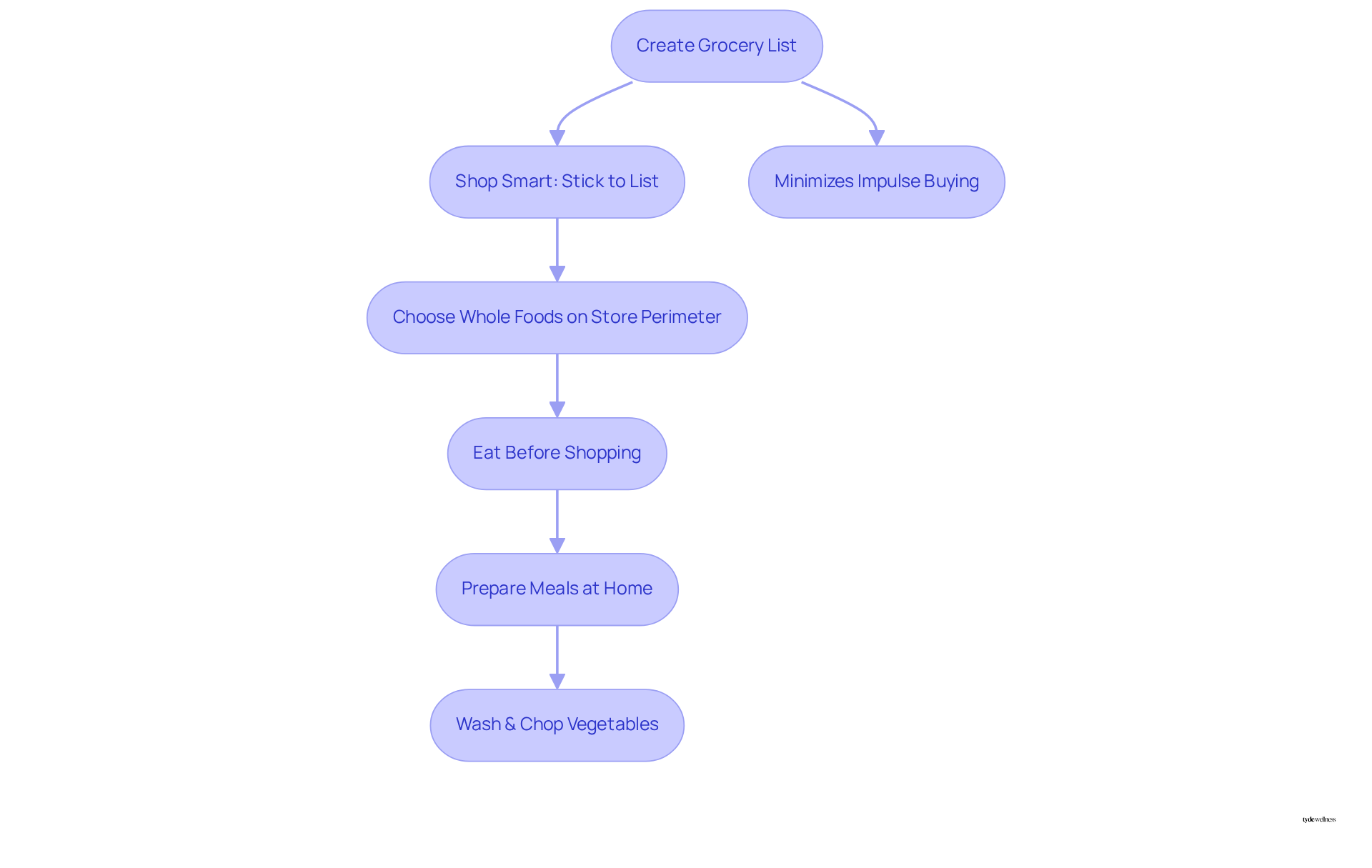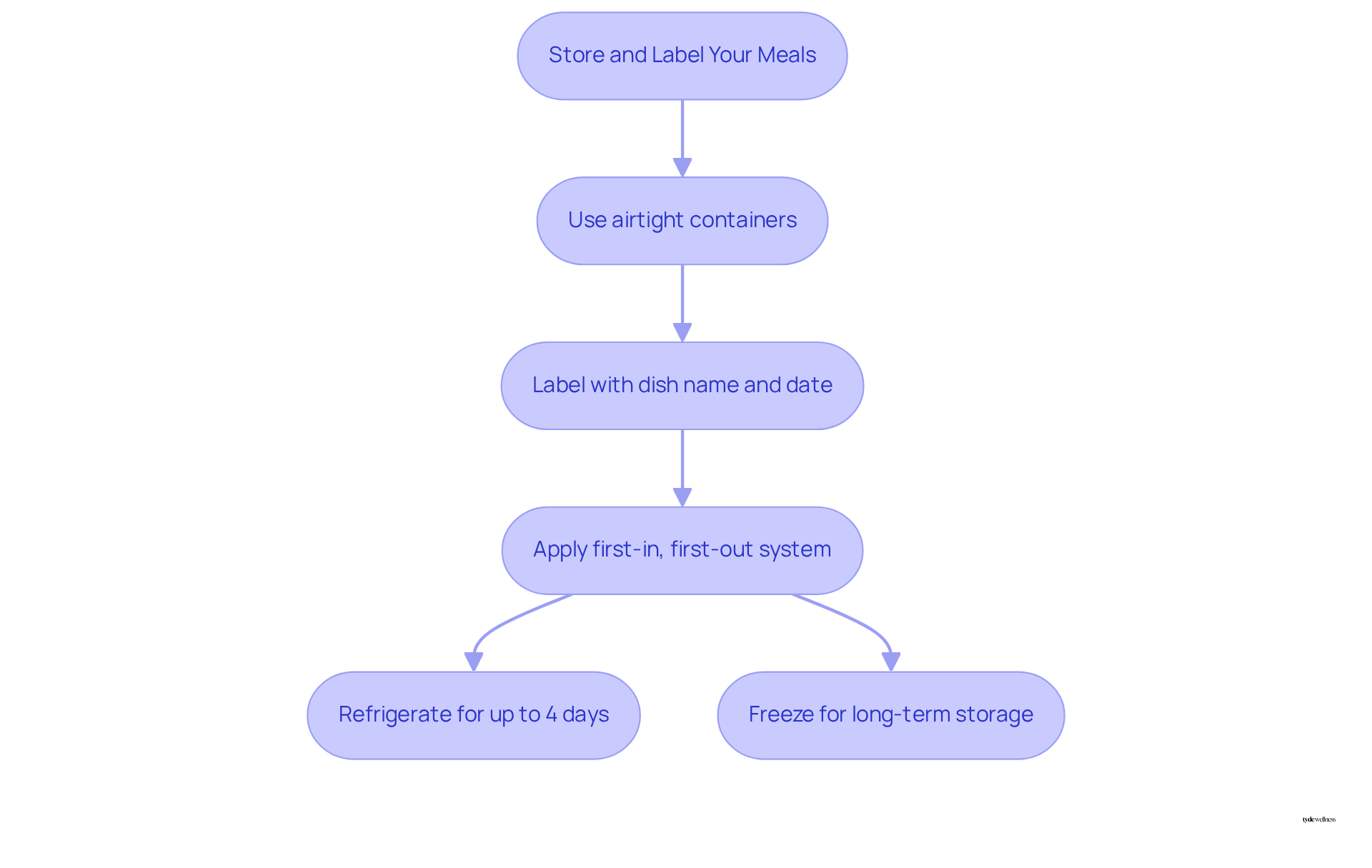Overview
Effective meal prepping for weight loss involves strategic planning, which includes:
- Selecting nutritious recipes
- Batch cooking
- Employing proper storage techniques
These practices facilitate healthier eating throughout the week. By organizing meals in advance, individuals can avoid impulsive eating, thereby better adhering to their dietary goals. This approach is supported by evidence indicating significant weight loss success among participants in structured meal prep programs.
Introduction
Meal prepping has emerged as a powerful strategy for individuals aiming to achieve weight loss goals, providing a structured approach to healthier eating. By organizing meals in advance, individuals not only save time but also foster better dietary habits, helping them avoid impulsive food choices.
Despite its numerous benefits, many still encounter challenges when initiating meal prepping. What if there were a straightforward guide to help navigate this transformative process?
Understand Meal Prepping Basics
Meal prepping for weight loss is a strategic method for organizing dishes or components ahead of time, which facilitates healthier eating throughout the week. This practice not only saves time and reduces stress but also is vital for meal prepping for weight loss, which is essential for achieving successful results. According to nutritionists, meal prepping for weight loss can lead to better dietary choices and help individuals avoid the pitfalls of impulsive eating. Participants at Tyde Wellness often achieve weight loss exceeding 20-25% within a year, reinforcing the effectiveness of meal prepping for weight loss as a key component of their weight loss strategy.
Key components of meal prepping include:
- Recipe Selection: Choose nutritious recipes that you enjoy and that fit your dietary needs. Incorporating a variety of food groups ensures balanced nutrition and keeps dishes interesting. As Brierley Horton, M.S., RD, notes, “We always hear—and say, as health experts—that eating a variety of foods is important.”
- Batch Cooking: Prepare larger quantities of proteins, grains, and vegetables at once. This approach allows for flexibility in food combinations throughout the week, making it easier to adhere to healthy eating habits.
- Proper Storage: Utilize airtight containers to maintain food freshness and organization. Labeling dishes with dates can assist in monitoring freshness and managing rotation effectively.
For busy women, meal prepping for weight loss provides significant advantages. It enables the creation of nutritious dishes that are ready to consume, minimizing the temptation to opt for takeout or processed items. Furthermore, individuals can effectively manage their hectic routines and health objectives by meal prepping for weight loss, organizing food choices for moments when nutritious eating is most challenging. Allocating specific time for food preparation is crucial for overcoming obstacles to nutritious eating.
Effective food preparation techniques involve starting with a few dishes each week and progressively expanding as confidence grows. This approach helps build sustainable habits without overwhelming changes. It is important to avoid strict calorie limits, particularly those under 1,500 calories per day, to ensure a healthy approach to food preparation. By incorporating these food preparation fundamentals into your routine, you can empower yourself to make informed decisions that align with your goals for meal prepping for weight loss and enhance your overall quality of life.

Set Your Weight Loss Goals
Begin by outlining your reduction objectives using the SMART criteria: Specific, Measurable, Achievable, Relevant, and Time-bound. For example, instead of saying, ‘I want to reduce my body mass,’ specify, ‘I intend to shed 10 pounds in three months by planning my meals and exercising three times a week.’ Document your goals and keep them visible to sustain motivation.
Regularly review and adjust your goals as necessary to ensure you remain on track. Research indicates that individuals who set clear targets for body mass reduction are more likely to succeed, with many achieving significant results through structured strategies such as meal preparation.
At Tyde Wellness, participants often experience mass reductions exceeding 20-25% within a year, underscoring the importance of establishing clear goals. Furthermore, tracking your progress is essential; consider utilizing journals or apps to record your journey.
If you face emotional eating triggers, recognize them and engage in alternative activities, such as journaling or walking, to cope. Embrace this approach to transform your journey towards a healthier body into a manageable and rewarding experience.
![]()
Create a Weekly Meal Plan
To create an effective weekly food plan, start with meal prepping for weight loss by selecting recipes that align with your weight loss goals. Focus on incorporating a variety of lean proteins, whole grains, healthy fats, and an abundance of fruits and vegetables. Given the demands of a hectic lifestyle, meal prepping for weight loss should involve prioritizing dishes that can be prepared in large quantities or those that reheat easily, ensuring convenience throughout the week. Utilizing a planning template for meal prepping for weight loss can enhance your organization, allowing you to outline dishes for breakfast, lunch, dinner, and snacks. This structured approach not only keeps you on track but also minimizes the temptation to resort to unhealthy choices.
By engaging in meal prepping for weight loss, strive to plan an average of five to seven dishes each week, as this can significantly improve your consistency and success in achieving your weight loss goals. Additionally, consider recipes that have proven effective for others, such as:
- High-protein salads
- Vegetable stir-fries
- Hearty soups
These options are not only nutritious but also satisfying. By integrating these strategies, you can establish a routine for meal prepping for weight loss that aligns with your health aspirations.

Shop Smart and Prepare Meals
To enhance your weight loss efforts, start by creating a grocery list aligned with your food plan. This straightforward step can significantly minimize impulse purchases; studies reveal that around 70% of shoppers who adhere to a list opt for healthier choices, as highlighted by researchers like Payne and colleagues. Emphasize whole, unprocessed foods, and navigate the store’s perimeter, where fresh produce, lean meats, and dairy products are typically located. Furthermore, consider consuming a nutritious dish or snack prior to grocery shopping to help mitigate impulsive buying.
Once you return home, designate a specific day for food preparation. Initiate the process by washing and chopping vegetables, cooking whole grains, and preparing lean proteins. Bulk preparation not only saves time but also ensures that healthy options are readily available throughout the week. For instance, many participants in Tyde Wellness programs report feeling more satisfied and less likely to stray from their dietary goals when they have nutritious meals prepped in advance.
Incorporating these practices into your routine can foster sustainable weight loss. Participants in these programs have reported an average body weight loss of 15% after 68 weeks, alongside improvements in overall health.

Store and Label Your Meals Effectively
To enhance the success of your food preparation, it is essential to utilize airtight containers. This practice helps maintain freshness and prevents contamination. Each container should be clearly marked with the dish name and the date it was prepared. This labeling aids in monitoring freshness and ensures food safety. For effective labeling, consider using painter’s tape and permanent markers for easy identification. Furthermore, to avoid food waste, apply the first-in, first-out system, ensuring that older dishes are consumed prior to newer ones.
For food intended for consumption within a few days, it should be kept in the refrigerator; otherwise, freezing is suitable for extended storage. Most prepared dishes can be safely stored in the fridge for up to four days, while frozen options can endure several months without jeopardizing safety. Proper storage not only preserves the flavor and texture of your meals but also significantly reduces the risk of foodborne illnesses. As food safety experts emphasize, timely storage of leftovers is crucial to avoid potential health risks.

Conclusion
Meal prepping for weight loss is a powerful strategy that streamlines healthy eating, reduces stress, and helps achieve weight loss goals. By organizing meals in advance, individuals can make informed dietary choices that align with their health objectives, ultimately leading to more consistent results. This proactive approach fosters better eating habits and empowers individuals to take control of their nutritional journey.
Essential steps for effective meal prepping include:
- Understanding the basics of meal preparation
- Setting realistic weight loss goals
- Creating a weekly meal plan
- Shopping smartly
- Storing meals properly
Each of these components contributes to a sustainable and enjoyable meal prepping routine, ensuring that nutritious options are readily available while minimizing the temptation to indulge in unhealthy foods. Incorporating a variety of recipes and utilizing smart storage techniques can enhance the meal prepping experience and support weight loss efforts.
Embracing meal prepping for weight loss goes beyond merely preparing food; it fosters a healthier lifestyle and encourages empowered choices. As individuals embark on this journey, it is crucial to remain adaptable and open to adjusting goals and strategies as needed. By committing to this practice, anyone can cultivate a rewarding relationship with food that promotes well-being and long-term success. Start today by implementing these tips and witness the transformative impact meal prepping can have on achieving weight loss goals.
Frequently Asked Questions
What is meal prepping for weight loss?
Meal prepping for weight loss is a strategic method of organizing dishes or components ahead of time to facilitate healthier eating throughout the week. It saves time, reduces stress, and helps individuals make better dietary choices, avoiding impulsive eating.
What are the key components of meal prepping?
The key components of meal prepping include recipe selection, batch cooking, and proper storage. Recipe selection involves choosing nutritious recipes that fit dietary needs, batch cooking means preparing larger quantities of food at once for flexibility, and proper storage utilizes airtight containers to maintain freshness.
How can meal prepping benefit busy women?
Meal prepping provides busy women with significant advantages by creating nutritious dishes that are ready to consume, reducing the temptation to choose takeout or processed foods. It helps manage hectic routines while aligning with health objectives.
What approach should one take when starting meal prepping?
A recommended approach is to start with a few dishes each week and gradually expand as confidence grows. This helps build sustainable habits without overwhelming changes.
What should be avoided when meal prepping for weight loss?
It is important to avoid strict calorie limits, particularly those under 1,500 calories per day, to ensure a healthy approach to food preparation.
How can I set effective weight loss goals?
Use the SMART criteria to outline your weight loss goals: Specific, Measurable, Achievable, Relevant, and Time-bound. For example, specify a goal like ‘I intend to shed 10 pounds in three months by planning my meals and exercising three times a week.’
Why is tracking progress important in weight loss?
Tracking progress is essential as it helps individuals stay on track with their goals. Using journals or apps can aid in recording the journey and adjusting goals as necessary.
How can I cope with emotional eating triggers?
Recognizing emotional eating triggers and engaging in alternative activities, such as journaling or walking, can help cope with these triggers and support a healthier approach to eating.
List of Sources
- Understand Meal Prepping Basics
- Meal prep for weight loss: Benefits, meal ideas, tips, and more (https://medicalnewstoday.com/articles/how-to-meal-prep-for-weight-loss)
- Meal Prep is a Game Changer (https://ballstatedailynews.com/article/2023/10/meal-prep-is-a-game-changer)
- Meal Prep for Weight Loss: 8 Ways It Will Make You More Successful (https://eatingwell.com/article/291319/meal-prep-for-weight-loss-8-ways-it-will-make-you-more-successful)
- Can You Lose Weight by Meal Prepping? | Blog (https://njadvancedsurgery.com/health-fitness/can-you-lose-weight-by-meal-prepping)
- The Ultimate Guide to Meal Prepping for Weight Loss (https://healthline.com/nutrition/meal-prep-for-weight-loss)
- Set Your Weight Loss Goals
- How to create SMART weight loss goals and achieve them | Medicare for Me (https://aspirehealthplan.org/create-smart-weight-loss-goals)
- Setting Weight Loss Goals That Work For You (https://healthline.com/health/weight-loss/setting-weight-loss-goals)
- 5 Steps to SMART Weight Loss Goals | Granville Health System (https://ghshospital.org/blog/losing-weight-the-smart-way)
- SMART Goals for Healthy Weight | Cardi-OH Article | Cardi-OH | Improving Cardiovascular and Diabetes Outcomes for Ohio Medicaid (https://cardi-oh.org/resources/smart-goals-for-healthy-weight)
- Setting Up Weight Loss Resolutions for Success | McLaren Health Care News (https://mclaren.org/main/news/setting-up-weight-loss-resolutions-for-success-4871)
- Create a Weekly Meal Plan
- How to Start a Beginner-Friendly Weight Loss Program with Meal Planning (https://diet.mayoclinic.org/us/blog/2025/how-to-start-a-beginner-friendly-weight-loss-program-with-meal-planning)
- Meal Planning for Weight Loss: Tips, Recipes, and More (https://healthline.com/nutrition/weight-loss-meal-plan)
- Weight loss meal plans: Tips, 7-day menu, and more (https://medicalnewstoday.com/articles/weight-loss-meal-plan)
- Here’s an Easy 7-Day Meal Plan for Weight Loss (https://verywellfit.com/easy-weight-loss-meal-plans-3495471)
- Weight-Loss Meal Plans (https://eatingwell.com/category/4305/weight-loss-meal-plans)
- Shop Smart and Prepare Meals
- 9 Tips for Healthy Grocery Shopping · Conway Medical Center (https://conwaymedicalcenter.com/news/topic/healthy-grocery-shopping-hacks)
- If You Want to Lose Weight, Consider Using These Ingredients (https://health.com/weight-loss/weight-loss-grocery-list)
- How to Start a Beginner-Friendly Weight Loss Program with Meal Planning (https://diet.mayoclinic.org/us/blog/2025/how-to-start-a-beginner-friendly-weight-loss-program-with-meal-planning)
- 7 Ways to Hack Your Grocery Trip for Weight Loss (https://health.usnews.com/wellness/slideshows/7-ways-to-hack-your-grocery-trip-for-weight-loss)
- 9 Grocery Shopping Tips (https://heart.org/en/healthy-living/healthy-eating/cooking-skills/shopping/grocery-shopping-tips)
- Store and Label Your Meals Effectively
- Food Storage and Safety Tips | UGA Online | Online Degrees, Certificates and Courses (https://online.uga.edu/news/food-storage-safety-tips)
- Tips for Meal Prep Storage (https://extension.msstate.edu/blog/tips-for-meal-prep-storage)
- 12 genius food storage tips to help your food last longer (https://sanitarium.com/nz/health-nutrition/nutrition/food-storage-tips-to-help-your-food-last-longer)
- Keep it fresh with these food storage tips (https://portland.gov/bps/garbage-recycling/news/2025/4/30/keep-it-fresh-these-food-storage-tips)
- What’s the Proper Way to Store Leftover Food? (https://news.ncsu.edu/2024/10/how-to-store-leftovers-safely)